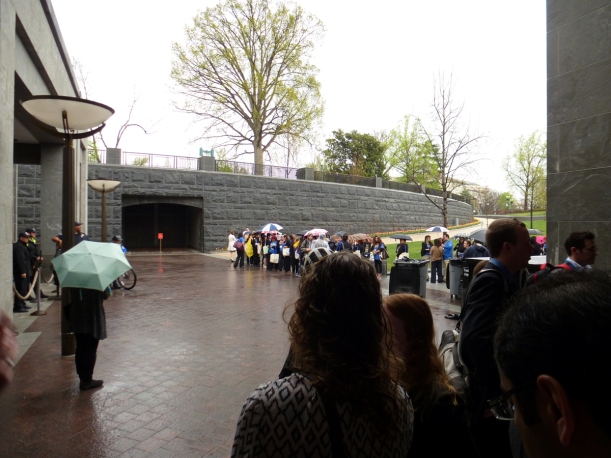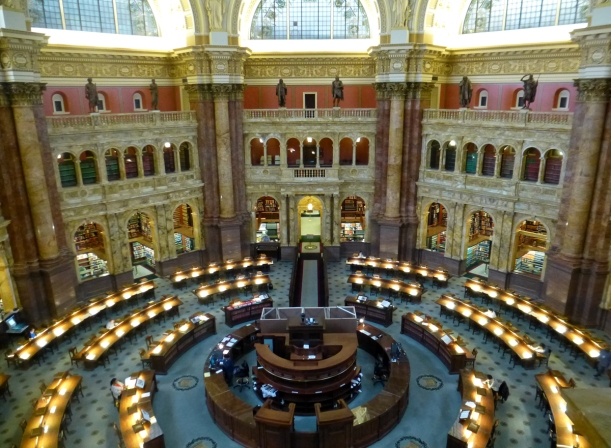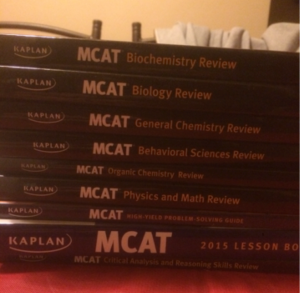This past week, I, along with fellow PSU Chemistry grad student Jared Mondschein, battled our way through horrible traffic into Washington, DC to attend a 2-day workshop about science policy given by the American Association for the Advancement of Science (AAAS). The Making our CASE (CASE=Catalyzing Advocacy in Science and Engineering; DC loves acronyms) workshop brought together students from over 40 different institutions to learn about how science is funded by our government, how science serves the public interest, and how we, as scientists, can better be a part of those processes. The first night featured a networking reception in the Washington Plaza Hotel where the workshop was held and which provided easy access to the AAAS building as well as the Capitol complex.
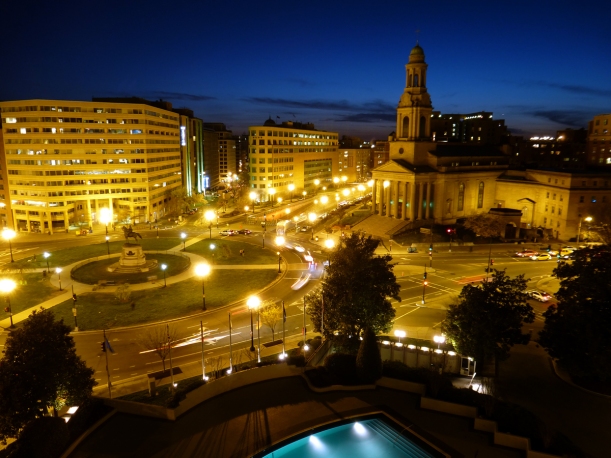
View from our hotel room west across Thomas Circle and Downtown. Unfortunately, the pool wasn’t yet open for Spring…
The workshop began in earnest the next morning with a session about how the federal budget process works and the role of various agencies in creating and advising on the budget, which was led by AAAS staff and folks from the legislative and executive branches of the U.S. government, including the Office of Science and Technology Policy (OSTP, of course). Matt Hourihan covered the history of Research and Development (R+D, natch) funding in the budget, and discussed how R+D funding (in constant dollars) generally increased up to around 2004, but has since leveled off. In general, Defense spending accounts for about half of all the nation’s R+D expenditures, which was a little bit of a surprise to me. I was also surprised to learn that the National Science Foundation (NSF, which has been the major funder of almost all research I have been involved in as a graduate student), makes up a relatively small portion of the R+D budget. For the life sciences, the greatest source of funding by far is the National Institutes of Health (NIH).
 In the past, there has been strong bipartisan support for R+D, including basic research, as this is broadly recognized as a driver of economic growth and development. However, with sequestration and other budget cutting moves, R+D funding has been cut as well, and funding levels may be reduced through 2021 (depending on how the budgeting process plays out). For more info, check out the AAAS R+D Budget Primer.
In the past, there has been strong bipartisan support for R+D, including basic research, as this is broadly recognized as a driver of economic growth and development. However, with sequestration and other budget cutting moves, R+D funding has been cut as well, and funding levels may be reduced through 2021 (depending on how the budgeting process plays out). For more info, check out the AAAS R+D Budget Primer.
Much of the workshop focused on the particulars of how science funding is actually determined (proverbially, “how the sausage is made”). In this case, the R+D budget is determined in broadly the same way as other types of funding. The President puts forth a budget request, which is followed by proposed budgets from both the House and Senate. The two arms of Congress attempt to produce a budget that reconciles their spending differences and will also not be vetoed by the President. If this is not achieved by the end of each September, the government may shutdown…oops! As such, the proportion of the budget devoted to science is balanced with many other factors. However, since a decline following the Space Race, the proportion of federal discretionary spending allocated to R+D has remained fairly constant.
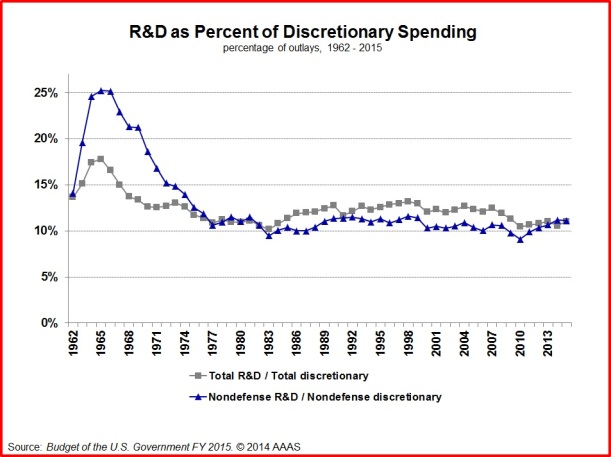 The afternoon of Day 1 featured a role-playing activity asking participants to work as congressional committee members to reconcile an appropriations bill and make hard science funding decisions. We also learned about the distinction between Policy for Science and Science for Policy. Policy for science refers to the government’s funding of science and directives for how that money is allocated to various agencies and the priorities given to different research areas. Science for policy is the use of scientific information to make informed policy decisions. Science for policy is one way in which scientists can serve the greater community. After a long day in conference rooms without seeing the sun, I took off to enjoy the lovely weather in DC (sunny and 70!) which had brought the cherry trees into full bloom. A 30 minute stroll from the hotel brought me to the National Mall and Tidal Basin where I enjoyed the beautiful trees (along with thousands of other people) and took in some familiar DC sights.
The afternoon of Day 1 featured a role-playing activity asking participants to work as congressional committee members to reconcile an appropriations bill and make hard science funding decisions. We also learned about the distinction between Policy for Science and Science for Policy. Policy for science refers to the government’s funding of science and directives for how that money is allocated to various agencies and the priorities given to different research areas. Science for policy is the use of scientific information to make informed policy decisions. Science for policy is one way in which scientists can serve the greater community. After a long day in conference rooms without seeing the sun, I took off to enjoy the lovely weather in DC (sunny and 70!) which had brought the cherry trees into full bloom. A 30 minute stroll from the hotel brought me to the National Mall and Tidal Basin where I enjoyed the beautiful trees (along with thousands of other people) and took in some familiar DC sights.
On the second day of the workshop, we ventured to the Capitol building and entered the new Congressional Visitor’s Center. We had a long wait on a rather rainy day, but once inside we were treated to a meeting with Rush Holt: former representative (D-NJ), plasma physicist, 5-time Jeopardy champion and defeater of IBM’s Watson, and current CEO of AAAS. We also listened to engaging presentations on how Congress is structured, and the finer points of how budgets are passed from subcommittees to become the law of the land. Towards lunchtime, we heard from a panel of congressional and committee staffers about how bills are negotiated in committees, and best ways to discuss issues with staffers.
On the way back to AAAS HQ for the afternoon sessions, Jared and I took the tunnel from the Capitol to the Library of Congress for a quick tour around the interior, which is beautiful. Definitely recommended if you find yourself in DC!
The final sessions of the workshop included discussions with lobbyists and advocates as well as some science policy career advice and discussions of jobs and fellowships, including the AAAS Science & Technology Policy Fellowships. Jared and I also worked together to craft an approach for our meetings with legislators and staff on the Hill that Penn State had lined up for us the next day. We had to create a simple, clear message that we could deliver in the 10-15 minute meetings that we had with the offices of various representatives and senators. We chose to focus on how Penn State supports a diversity of research programs, from my basic ecological research (the lizards from this blog!) to Jared’s work searching for new materials for fuel cells. Many types of research are needed to meet the ecological and technological challenges of living in a rapidly changing world. Both of our labs are supported by NSF, which is the primary government agency supporting most basic research. We also wanted to describe how Penn State encourages collaborations between departments and researchers and supports us in developing our projects.

Posing for a quick snapshot in front of AAAS HQ after a long day of meetings and strategerizing. This was quickly followed by a dinner of Disco Fries and Root beer and an early bedtime.
On our last day in DC, Jared and I worked the Hill from 9 in the morning to 7 in the evening. We met with staff from the offices of Pennsylvania’s two Senators, Bob Casey (D-PA) and Pat Toomey (R-PA), as well as Steve Israel (D-NY), Jared’s Congressman. We also personally spoke with two representatives: Rep. Pat Meehan (my own Congressman!, R-PA) and Glenn “GT” Thompson (R-PA), the representative for PA District 05, which contains Penn State. We also rode in an elevator with Rep John Lewis (!!, D-GA), who was super nice. In general, the folks we talked to were supportive of science funding at both the federal level and at Penn State in particular, but they acknowledged that most types of discretionary spending are under pressure in the current Congress. We also had the chance to attend an informal Penn State alumni get together and debate science funding with other representatives and staff from multiple agencies. Hopefully, our visits and discussions will have put a personal face to scientific research and communicated the importance of continuing federal support for scientific research.
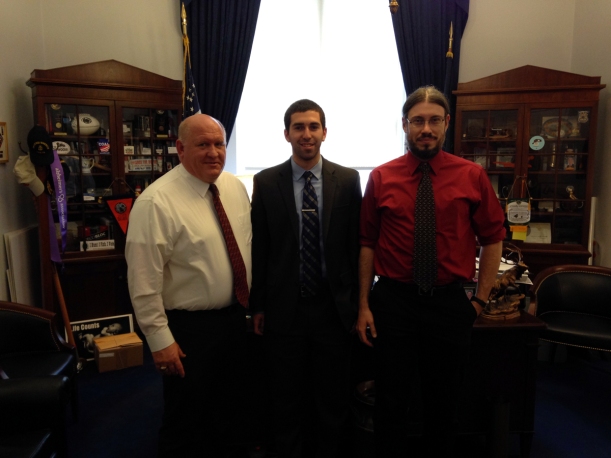
Meeting with Glenn “GT” Thompson in his office at the Capitol. Notice the Penn State football in the cabinet on the left! Also, I am probably the only person on Capitol Hill with any sort of facial hair.
All in all, the CASE workshop was a unique (and exhausting…so many meetings!) experience for me and an introduction into a part of the scientific process I have rarely considered. Hopefully, I will be able to use this experience to better communicate science to a broad range of audiences, including our elected officials, and advocate for science throughout my career.



